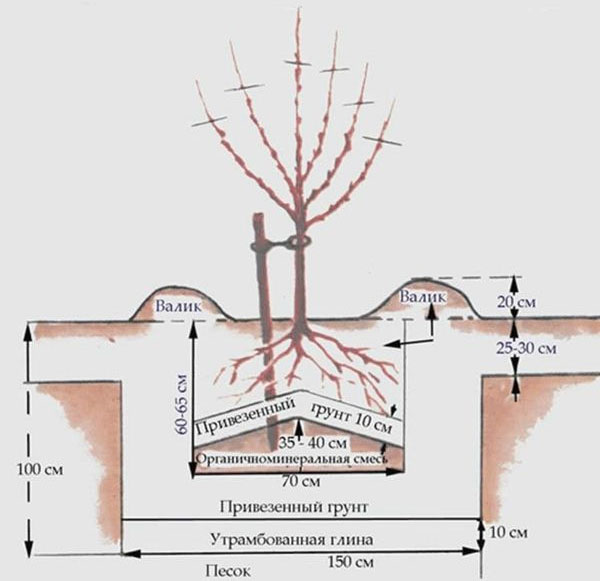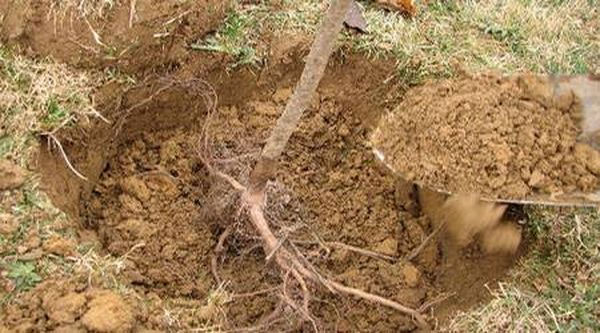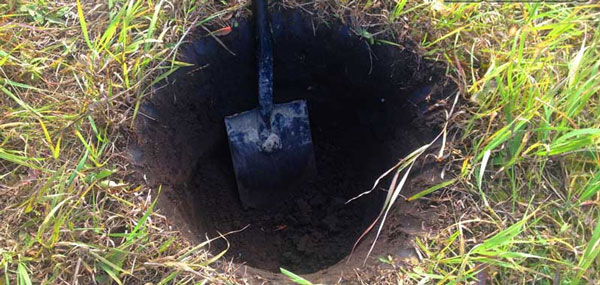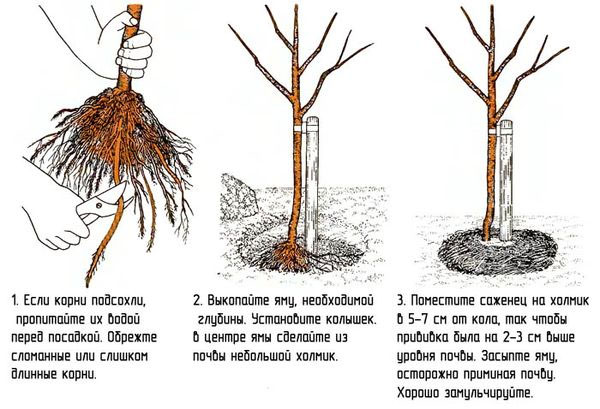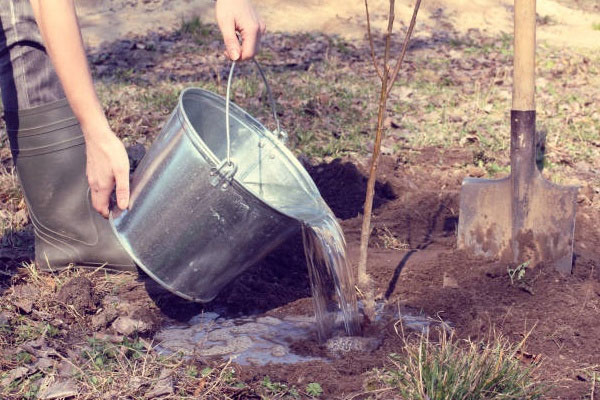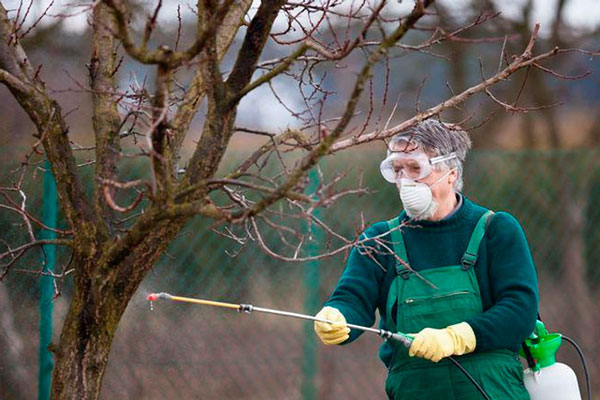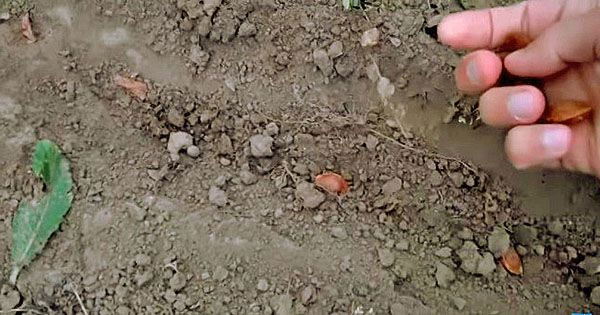Important rules for planting and further care for apricots
Content
Optimal timing for planting
The timing of planting an apricot seedling depends on the climatic zone. In the Moscow region and regions of central Russia, seedlings planted in open ground at the end of April are successfully taking root. Gardeners of the Volga region recommend planting seedlings of this fruit crop in late March or early April. For planting, take northern, winter-hardy varieties. Frost-resistant varieties of apricot are planted in the Urals and Siberia. Planting date - late April or early May. To protect against late spring frosts, young trees are covered with non-woven material.
It is necessary to plant fruit trees in the spring - before the start of active sap flow and swelling of the buds. Otherwise, the plant loses a lot of energy for adaptation and recovery.
Video "Preparing a pit and planting a seedling"
In this video, you will learn how to properly prepare a planting hole for a tree and plant a seedling.
Seedling selection and soil preparation
When choosing planting material, carefully inspect the seedling for damage to the bark and signs of decay. One- and two-year crops take root faster.
The optimum height of a young tree suitable for planting is 1–1.5 m. Low-growing crops are considered the result of improper cultivation, tall ones - an excessive amount of nitrogen-containing fertilizing in the soil.
A healthy seedling has one main root and 2-3 lateral roots. The lateral ramifications should be evenly spaced along the tree trunk. An apricot with branches with sharp angles of discharge is considered unsuitable for planting. With abundant fruiting, such branches can break off, which is fraught with the death of the fruit tree.
Apricot feels comfortable in black earth or loamy soil with neutral acidity. Saplings planted in peat or sandy soil slowly take root and bear poor fruit.
Landing pit requirements
Apricot is a light-loving and thermophilic fruit tree. When choosing a place for planting a seedling, it is recommended to take a closer look at areas of the garden open to the sun. In this case, the area must be protected from drafts and wind. The groundwater level is 2.5–3 m. The proximity of groundwater negatively affects the development of the root system of the tree and its yield.
According to experienced gardeners, apricot is considered an individual fruit crop. The plant does not tolerate the neighborhood with cherries, cherries, pears, peaches, apples and walnuts. As it grows, the apricot tree forms a wide and spreading crown. For this reason, when planting seedlings of fruit trees, it is recommended to maintain a distance of 3-4 m between the planting pits.
The apricot planting pit should be at least 70–80 cm deep and 65 cm wide. Drainage from broken bricks, gravel or rubble is laid out at the bottom of the pit. The height of the drainage layer is 5–7 cm.
You need to prepare the landing pit well in advance. If you are going to plant an apricot seedling in the spring, then the pit is being prepared in the fall. The soil will have time to be well saturated with air and moisture.
How to plant correctly
Upon completion of the preparatory work, you can start planting the seedling. You need to plant an apricot tree as follows:
- Soak the root system of the seedling a day before planting. The tree is saturated with moisture, biological processes will be restored in the roots.
- Prepare a creamy mess out of clay and dung. Dip the root system in the prepared mixture. Let the root dry well.
- Make an indentation in the center of the planting hole. Drizzle liberally with water. Install a wooden support.
- Place the seedling in this slot. Gently flatten the root system. When the root is uneven or there are creases, the young tree may die.
- Sprinkle the root with earth, gently tamp the soil. The root collar should be 4–5 cm above the ground.
- Tie the seedling to the previously installed support.
- Form a hole. Water the tree liberally around the edge of the tree trunk circle. You will need at least 2 buckets of settled water.
- Mulch the trunk circle with humus, peat. Mulch height - 4 cm.
Now let's figure out how to plant an apricot in the fall.
Autumn planting is no different from spring planting. The planting pit is prepared 3-4 weeks before planting the seedling in open ground. When making a chatterbox from clay and manure, keep an eye on the consistency of the mixture.
So that the apricot planted in autumn does not freeze at the first frost, the clay talker must be very thick. After drying, a layer of clay and manure of at least 3 cm remains on the roots.
Further care
At first, caring for an apricot planted in open ground consists in timely moistening the soil. At the same time, overflow and drying out of the soil is not allowed. It is necessary to determine the frequency and amount of watering according to the degree of soil drying.
When signs of insect pests appear, the fruit tree is treated with insecticidal preparations or time-tested folk remedies are used.
Apricot is a fast growing fruit crop. With proper care, the first time it gives an active increase - 1 m per year. In spring and autumn, crown pruning is carried out.
The first year after planting a seedling in a permanent place of growth, no fertilization is needed. The tree absorbs micronutrients that are in the soil.
Features of growing from a bone
Novice gardeners are interested in whether it is possible to grow an apricot from a stone. When propagating a fruit crop by seeds, it is necessary to take into account the varietal characteristics of the plant. So, for central Russia and the Moscow region, the following apricot varieties are suitable: Honey, Edelweiss, Saratov Ruby, Russian, Alyosha, Hurricane, Tsarsky, Northern Triumph, Samara, Vystaly, Aquarius, etc.
The collected seeds are thoroughly washed and filled with water for 24 hours. The bones that float to the surface of the water are thrown away, the rest are planted in the ground. In this case, the depth of the hole is 6–7 cm. The beds are preliminarily watered abundantly. After planting, the holes with seeds must be mulched with humus or compost.
You can plant apricot seeds in spring, summer or autumn. The deadline for planting in autumn is mid-October.
Experienced gardeners recommend focusing on the weather conditions and climatic features of the region where the culture is growing.
Care for young seedlings consists in watering, fertilizing, weeding and loosening the soil.


